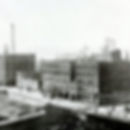
WHO WE ARE
The History of Guilford Hall Brewery

HISTORY & BUILDING
The three-part, five story building that occupies 1515 to 1611 Guilford Avenue was constructed in 1898 to house the rapidly expanding industry of Crown Cork & Seal. Founded in 1892 by William Painter, creator of the modern beer bottle cap, Crown Cork & Seal needed a large space in the heart of Baltimore where it could easily bottle the local libations. The company took off, as Painter’s “crown cork” technology was much more efficient and successful than previous cork sealing methods. In 1904, Crown Cork & Seal opened its first branch plant in Highlandtown, another neighborhood in Baltimore. The new plant took over crown cork manufacturing, while the Guilford location manufactured bottling machines and equipment. The company merged with the New Process Cork Company in 1927, which sparked an expansion of facilities and increased production. As of 1980, the company employed over 5,000 people in Baltimore at different plants.

HISTORICAL BREWING & GERMAN INFLUENCE
Baltimore is, and has always been, a beer city. Its first manufacturing industry started with a brewery on Hanover street in 1748, opened by German immigrant, John Leonard Barnitz. Previously, beer was brewed by women in their homes, in batches just enough for their own households. However, during the Revolutionary War, commercial brewing picked up as soldiers were promised daily beer rations as incentive. The city was a prime spot for beer production because of its large supply of clean water and access to railroads supplying grain. Brewing beer was a very different process back then, and was fully run by hand. Production was a slow process compared to today, yet Baltimoreans drank with the same gusto.

STATION NORTH
Station North, less commonly known as North Central Historic District, is a triangular-shaped, 25-block area north of downtown Baltimore. The district is described as “edgy” and “artistic,” home to exhibit spaces, live music venues, murals, and the iconic Club Charles cocktail bar. The area is bordered by North Avenue, Greenmount Avenue, and Falls Road, which runs along Jones Falls, a stream that empties into Baltimore Inner Harbor. John Wilkes Booth, stage actor and President Abraham Lincoln’s assassin, is buried in Green Mount Cemetery, which borders the east side of Station North.

